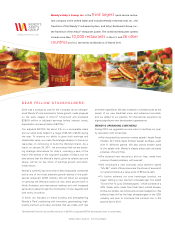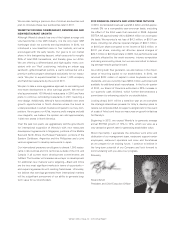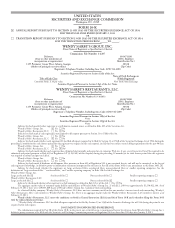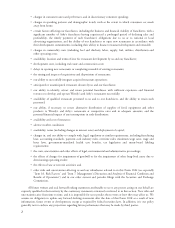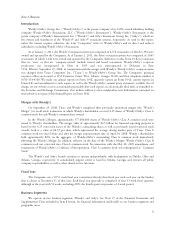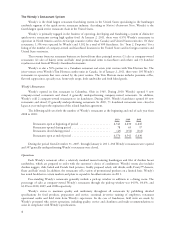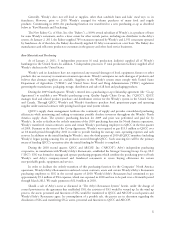Wendy's 2010 Annual Report Download - page 12
Download and view the complete annual report
Please find page 12 of the 2010 Wendy's annual report below. You can navigate through the pages in the report by either clicking on the pages listed below, or by using the keyword search tool below to find specific information within the annual report.Trademarks and Service Marks
Wendy’s or its subsidiaries have registered certain trademarks and service marks in the United States Patent and
Trademark Office and in international jurisdictions, some of which include Wendy’s®, Old Fashioned Hamburgers®
and Quality Is Our Recipe®. Wendy’s believes that these and other related marks are of material importance to its
business. Domestic trademarks and service marks expire at various times from 2011 to 2020, while international
trademarks and service marks have various durations of 10 to 15 years. Wendy’s generally intends to renew
trademarks and service marks that are scheduled to expire.
Wendy’s entered into an Assignment of Rights Agreement with the company’s founder, R. David Thomas, and
his wife dated as of November 5, 2000 (the “Assignment”). Wendy’s had used Mr. Thomas, who was Senior
Chairman of the Board until his death on January 8, 2002, as a spokesperson and focal point for its products and
services for many years. With the efforts and attributes of Mr. Thomas, Wendy’s has, through its extensive investment
in the advertising and promotional use of Mr. Thomas’ name, likeness, image, voice, caricature, endorsement rights
and photographs (the “Thomas Persona”), made the Thomas Persona well known in the United States and
throughout North America and a valuable asset for both Wendy’s and Mr. Thomas’ estate. Under the terms of the
Assignment, Wendy’s acquired the entire right, title, interest and ownership in and to the Thomas Persona, including
the sole and exclusive right to commercially use the Thomas Persona.
Seasonality
Wendy’s restaurant operations are moderately seasonal. Wendy’s average restaurant sales are normally higher
during the summer months than during the winter months. Because the business is moderately seasonal, results for
any quarter are not necessarily indicative of the results that may be achieved for any other quarter or for the full fiscal
year.
Competition
Each Wendy’s restaurant is in competition with other food service operations within the same geographical
area. The quick-service restaurant segment is highly competitive and includes well-established competitors such as
McDonald’s®, Burger King®, Taco Bell®, Kentucky Fried Chicken®and Arby’s®. Wendy’s competes with other
restaurant companies and food outlets, primarily through the quality, variety, convenience, price, and value
perception of food products offered. The number and location of units, quality and speed of service, attractiveness of
facilities, effectiveness of marketing and new product development by Wendy’s and its competitors are also important
factors. The price charged for each menu item may vary from market to market (and within markets) depending on
competitive pricing and the local cost structure. Wendy’s also competes within the food service industry and the quick
service restaurant sector not only for customers, but also for personnel, suitable real estate sites and qualified
franchisees.
Wendy’s competitive position is differentiated by a focus on quality, its use of fresh, never frozen ground beef in
the United States and Canada and certain other countries, its unique and diverse menu, its promotional products, its
choice of condiments and the atmosphere and decor of its restaurants.
Many of the leading restaurant chains have focused on new unit development as one strategy to increase market
share through increased consumer awareness and convenience. This has led to increased competition for available
development sites and higher development costs for those sites, although the recent decline in commercial real estate
values has somewhat offset those costs. Competitors also employ marketing strategies such as frequent use of price
discounting, frequent promotions and heavy advertising expenditures. Continued price discounting in the quick
service restaurant industry and the emphasis on value menus has had and could continue to have an adverse impact on
Wendy’s. In addition, the growth of fast casual chains and other in-line competitors could cause some fast food
customers to “trade up” to a more traditional dining out experience while keeping the benefits of quick service dining.
Other restaurant chains have also competed by offering high quality sandwiches made with fresh ingredients
and artisan breads and there are several emerging restaurant chains featuring high quality food served at in-line
locations. Several chains have also sought to compete by targeting certain consumer groups, such as capitalizing on
trends toward certain types of diets (e.g., low carbohydrate or low trans fat) by offering menu items that are promoted
as being consistent with such diets.
6


